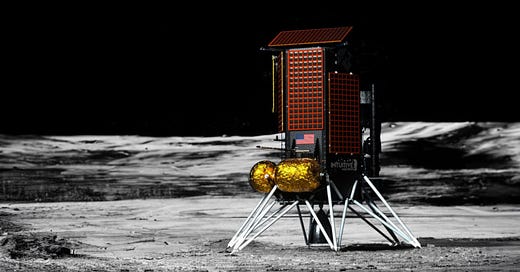NASA Awards Lunar Contract to Intuitive Machines
Will Deliver NASA Science Experiments And Technology Demonstrations to the Moon's South Pole
NASA has awarded a $116.9 million contract to Intuitive Machines to deliver six science and technology payloads, including one European Space Agency-led drill suite to the Moon’s South Pole. This award will leverage Intuitive Machines’ lunar delivery, data transmission, and autonomous operation capabilities to explore the region targeted for sustained human operations.
"The instruments on this newly awarded flight will help us achieve multiple scientific objectives and strengthen our understanding of the Moon's environment."
Chris Culbert, NASA
As part of NASA’s Commercial Lunar Payload Services (CLPS) initiative, this marks Intuitive Machines’ fourth contract award to deliver science and technology payloads and return valuable data while autonomously operating on the surface of the Moon.
“Over the last several years, we’ve witnessed NASA’s successful Artemis I mission and the campaign’s progress toward sustainably returning humans to the surface of the Moon, highlighting the importance of autonomous missions that advance humanity’s understanding of the Moon and the commercial services required to support the industry,” said Intuitive Machines CEO Steve Altemus. “Intuitive Machines looks forward to working closely with the NASA team to deliver mission success once again.”
"This marks the 10th CLPS delivery NASA has awarded, and the fourth planned for delivery to the South Pole of the Moon," said Joel Kearns, deputy associate administrator for exploration, Science Mission Directorate, NASA Headquarters in Washington. "By supporting a robust cadence of CLPS flights to a variety of locations on the lunar surface, including two flights currently planned by companies for later this year, NASA will explore more of the Moon than ever before."
NASA has awarded Intuitive Machine's four task orders. The company delivered six NASA payloads to Malapert A in the South Pole region of the Moon in early 2024. With this lunar South Pole delivery, Intuitive Machines will be responsible for payload integration, launch from Earth, safe landing on the Moon, and mission operations.
"The instruments on this newly awarded flight will help us achieve multiple scientific objectives and strengthen our understanding of the Moon's environment," said Chris Culbert, manager of the CLPS initiative at NASA's Johnson Space Center in Houston. "For example, they'll help answer key questions about where volatiles – such as water, ice, or gas – are found on the lunar surface and measure radiation in the South Pole region, which could advance our exploration efforts on the Moon and help us with continued exploration of Mars."
Commercial payload mass is expected to be available in addition to CLPS payloads, including:
Package for Resource Observation and In-Situ Prospecting for Exploration, Characterization, and Testing (PROSPECT) is a suite of instruments that will extract samples from beneath the lunar surface to identify possible volatiles (water, ice, or gas) trapped at extremely cold temperatures. PROSPECT is led by the European Space Agency.
Laser Retroreflector Array (LRA) is a collection of eight retroreflectors that enable precision lasers to measure the distance between the orbiting or landing spacecraft to the reflector on the lander. The array is a passive optical instrument and will function as a permanent location marker on the Moon for decades to come. LRA is managed by NASA’s Goddard Space Flight Center.
Surface Exosphere Alterations by Landers (SEAL) will investigate the chemical response of lunar regolith to the thermal, physical, and chemical disturbances generated during a landing and evaluate contaminants injected into the regolith by the lander. It will give insight into how a spacecraft landing might affect the composition of samples collected nearby. SEAL is managed by NASA’s Goddard Space Flight Center.
Fluxgate Magnetometer (MAG) will characterize certain magnetic fields to improve the understanding of energy and particle pathways at the lunar surface and is managed by NASA’s Goddard Space Flight Center.
Lunar Compact Infrared Imaging System (L-CIRiS) will deploy a radiometer – a device that measures infrared wavelengths of light – to explore the Moon’s surface composition, map its surface temperature distribution, and demonstrate the instrument’s feasibility for future lunar resource utilization activities. L-CIRiS is managed by the Laboratory for Atmospheric and Space Physics at the University of Colorado at Boulder.
Intuitive Machines is in the final assembly phase of its second lunar mission and is scheduled to deliver the completed lander to the launch facility in late 2024. In parallel, the Company is continuing work on its third lunar mission and is preparing for systems integration and testing.





